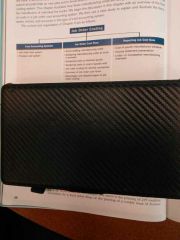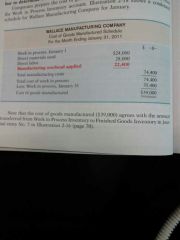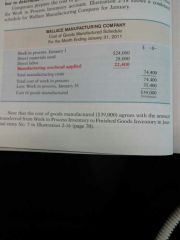![]()
![]()
![]()
Use LEFT and RIGHT arrow keys to navigate between flashcards;
Use UP and DOWN arrow keys to flip the card;
H to show hint;
A reads text to speech;
5 Cards in this Set
- Front
- Back

Job Order Costing
Cost accounting systems, Job Order Cost flow, Reporting Job Cost Data |
Cost Accounting Systems
*Job Order costing *Process costing Job Order Cost Flow *Accumulating Manufacturing Costs *Assigning Manufacturing Costs to work in process *Assigning costs to finished goods *Assigning costs to cost of goods sold *Job Order Costing for service companies *Summary of job order cost flows *Advantages and disadvantages of job order Costing Reporting Reporting Job Cost Data *Cost of goods manufactured schedule *Income statement presentation *Under/Over applied manufacturing overhead |
|
|
Cost Accounting Systems
|
Cost Accounting involves the measuring, recording, and reporting of product costs. Total and unit costs are accounted for, accuracy of product cost information is critical to company success. Cost accounting helps companies determine what to produce, how much to charge, and how much to produce. Also helpful with employee performance evaluations. Cost accounting systems use a perpetual inventory system which provides immediate, up to date information on the cost of a product.
Job Order Cost System - Objective is to compute cost per job. Company assigns costs to each job or to each batch of goods. Each job or batch has its own distinguishing characteristics. Process Cost System - Objective is to compute product related cost for a specific period of time. Used when manufacturing large volume of similar products, production is continuous. |
|
|
Job Order Cost Flow
|

The flow of costs(direct materials, direct labor, manufacturing overhead) parallels the physical flow of the materials as they are converted into finished goods. Manufacturing Costs ->Work in process->Finished Goods->Cost of goods sold
Step 1.Accumulating manufacturing costs(purchasing raw materials, incurring labor cost and manufacturing overhead) Step 2.Assigning Manufacturing Costs to Work in Process(raw materials to specific jobs work in process or MOH, assign labor to work in process account or MOH, assign MOH to work in process using predetermined overhead) Step 3.Assigning costs to finished goods(as completed cost is transferred from work in process to finished goods inventory) Step 4.Assigning costs to costs of goods sold(as items are sold costs are transferred from finished goods to cost of goods sold) |
|
|
Advantages &Disadvantages
|
Pros
More precise in assignment of costs to projects than process costing Cons Significant amount of data entry, time consuming. |
|
|
Reporting Job Cost Data & Under/Over applied
|

Costs of goods manufactured schedule - shows overhead applied as opposed to actual overhead costs. Added to direct materials and direct labor to account for total manufacturing costs.
Income statement - no change from the standard. When manufacturing overhead has a debit balance overhead is Under applied which means the overhead assigned to work in process is less than the overhead incurred. @ the end of year debited to cost of goods sold When manufacturing overhead has a credit balance overhead is over applied which means the overhead assigned to work in process is more than the overhead incurred. @ the end of year credited to cost of goods sold |

